Key takeaways
- Buffer simplifies post scheduling, allowing bloggers to plan content in advance and reduce stress related to timing.
- Consistent posting through scheduling helps build a loyal readership and encourages creativity by freeing up time for idea generation.
- Customizing posting times and regularly evaluating engagement data ensure content reaches the audience effectively.
- Engaging posts are driven by understanding the audience, incorporating storytelling, and varying content formats to keep the blog dynamic.
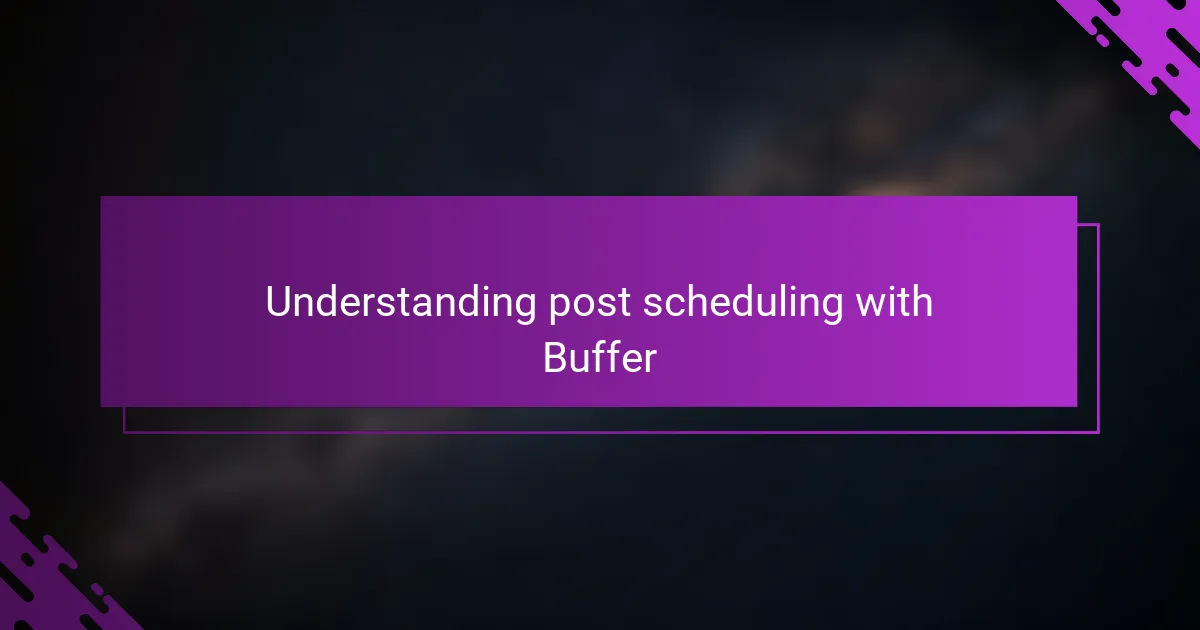
Understanding post scheduling with Buffer
When I first explored Buffer, I was struck by how intuitive the platform made scheduling posts. It’s not just about choosing a time—I realized Buffer lets you plan your entire content calendar, freeing up mental space for creativity instead of constant posting stress. Have you ever felt overwhelmed trying to keep up with multiple social channels? Buffer’s post scheduling tackles exactly that by letting you queue content in advance.
What really clicked for me was understanding how Buffer’s scheduling aligns with peak audience activity. Instead of guessing when to post, I could rely on Buffer’s analytics to put my content in front of people at the right moments. That feeling of control, knowing my posts would reach followers without me being glued to my screen, was surprisingly empowering.
Beyond just timing, Buffer helps you visualize your posting rhythm, which changed how I approach my blogging schedule. Seeing my planned posts at a glance encouraged me to mix content types and keep a consistent voice. It’s more than a tool—it’s like having a trusted assistant who keeps my personal blog running smoothly, even on my busiest days.
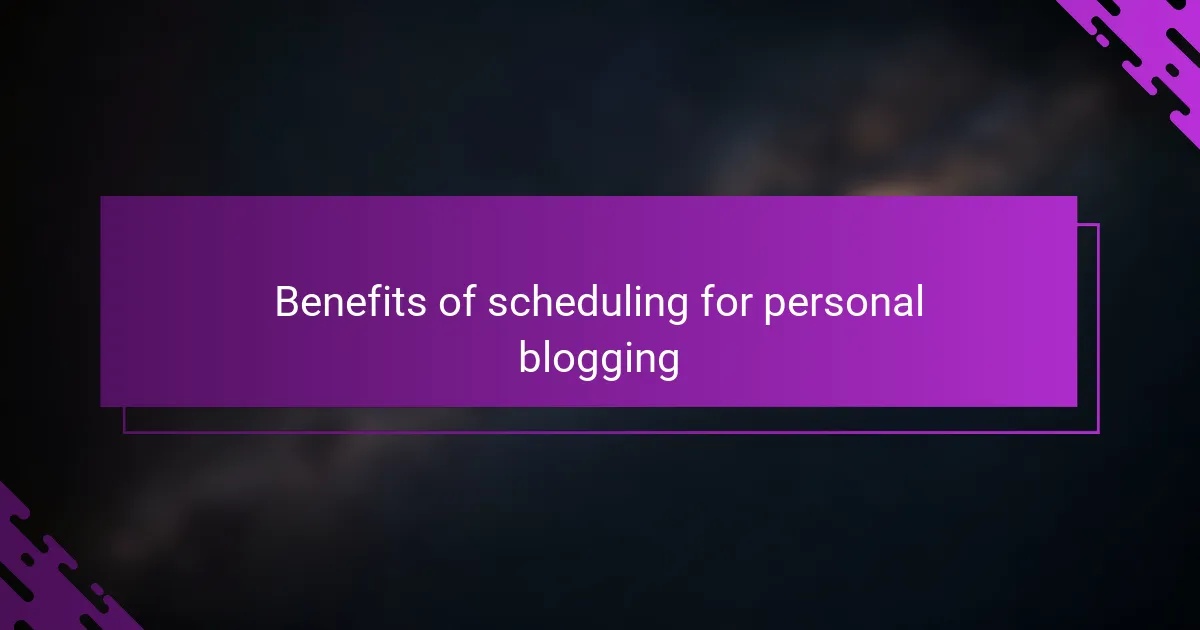
Benefits of scheduling for personal blogging
One of the biggest benefits I found with scheduling posts is how it relieved my stress around content timing. Instead of scrambling to post at random moments, I could set everything up in one session and then trust Buffer to do the rest. Have you ever experienced that anxious rush to hit “publish” exactly when your audience might be online? Scheduling removed that pressure entirely.
Another thing I noticed was how scheduling helped me stay consistent, which is key for building a loyal readership. I didn’t have to wonder if I’d forgotten to publish something; Buffer keeps my blog active without daily effort. That steady presence really boosted my confidence, knowing my readers would always find fresh content waiting for them.
Plus, scheduling opened up space for creativity. With posts lined up, I wasn’t stuck in a constant loop of immediate deadlines. This freedom let me experiment with new ideas, knowing I had a buffer zone between creating and sharing. Isn’t it amazing how having a bit of breathing room can improve your writing flow? For me, it made personal blogging feel less like a chore and more like an enjoyable conversation.
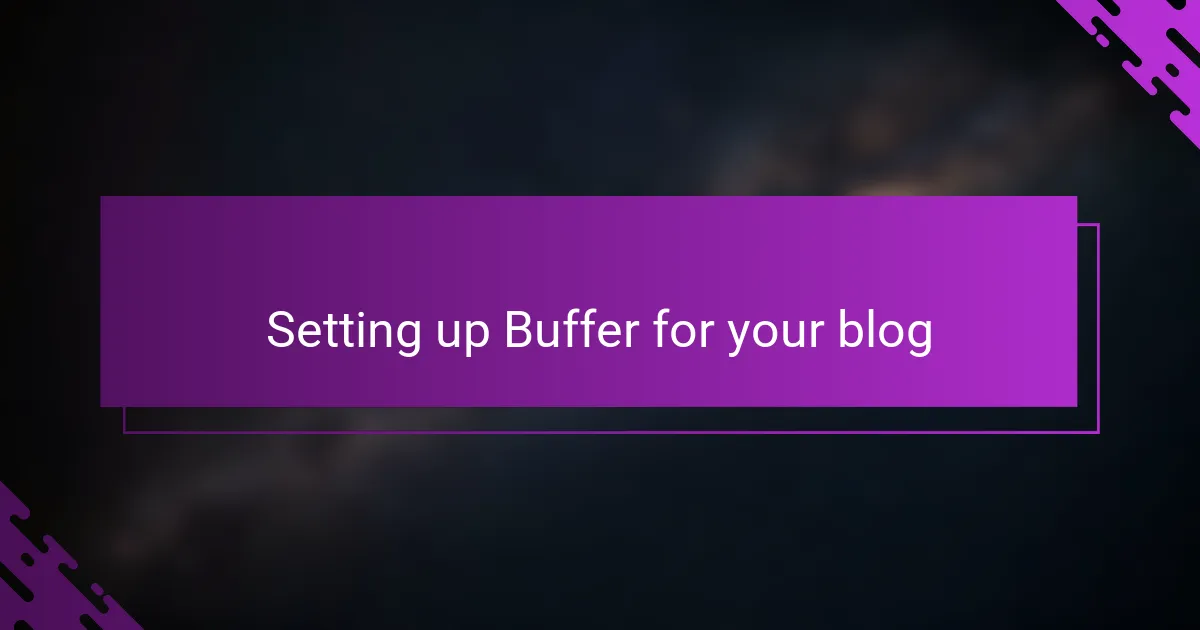
Setting up Buffer for your blog
Setting up Buffer for your blog was surprisingly straightforward for me. After linking my social accounts, I appreciated how the dashboard immediately showed me where to start—whether it was creating a posting schedule or adding content to the queue. Have you ever felt lost with new tools? Buffer eliminated that confusion by guiding me step-by-step.
One feature that stood out during setup was customizing my posting times. Buffer lets you choose specific days and hours, which was perfect for syncing with when my readers are most active. I remember tweaking my schedule a few times based on early engagement insights, turning initial guesses into a data-driven routine that felt just right.
What really made the setup feel personal was the ability to draft posts with images, hashtags, and links all in one place. It saved me from juggling multiple platforms and helped me keep my voice consistent across channels. Doesn’t having a neat, all-in-one space just make the whole blogging process feel less chaotic? For me, that simplicity became a game-changer.

Planning content calendar effectively
Planning a content calendar effectively shifted everything for me. Instead of randomly deciding what to post each day, I started setting clear themes and goals for each week. Have you ever noticed how a scattered plan makes blogging feel chaotic? Pinning down topics ahead of time gave me a sense of purpose and made the whole process less stressful.
I also learned that spacing out different types of content keeps my audience interested and me motivated. Sometimes I’d schedule a how-to post, then follow it with a personal story or a quick tip. That variety not only made my calendar more engaging but also made me look forward to creating each piece. It’s amazing how a well-balanced plan can turn blogging from a task into something enjoyable.
One practical trick that worked for me was blocking out specific days just for brainstorming and drafting content. Knowing I had a dedicated time to generate ideas freed me from the pressure of last-minute scrambles. When you plan your calendar this way, it feels less like juggling and more like a steady rhythm—and that steady rhythm, in my experience, is the secret to staying consistent without burnout.
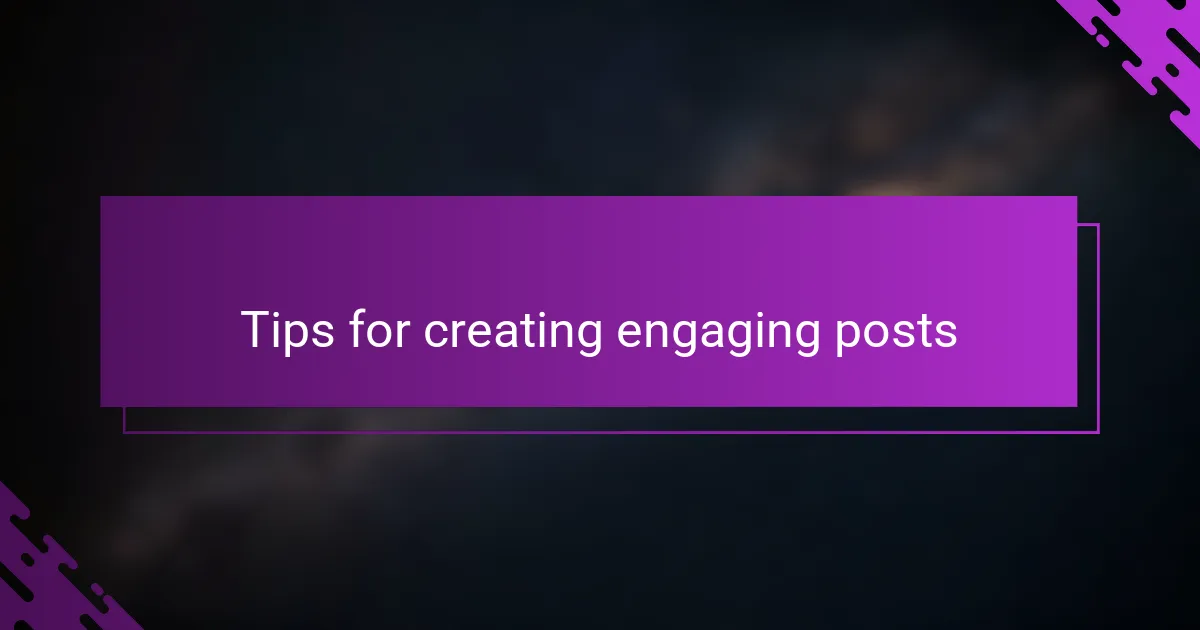
Tips for creating engaging posts
Engaging posts start with knowing your audience. I used to write whatever came to mind until I asked myself, “What really sparks my readers’ interest?” Once I focused on topics they cared about, the comments and shares naturally increased. Isn’t it more rewarding when your blog feels like a genuine conversation rather than a monologue?
I also found that storytelling adds a personal touch that hooks readers instantly. Sharing a brief experience or lesson makes the content relatable and memorable. For example, I once wrote about a blogging mishap, and the responses were overwhelmingly supportive—proof that vulnerability can turn followers into a community.
Finally, mixing up your post formats keeps things fresh and keeps readers coming back. Whether it’s a question, a how-to, or a quick tip, varying your approach avoids monotony. Have you tried breaking away from your usual style? When I did, my engagement went from sporadic to steadily growing, which made all the difference in keeping my blog lively.
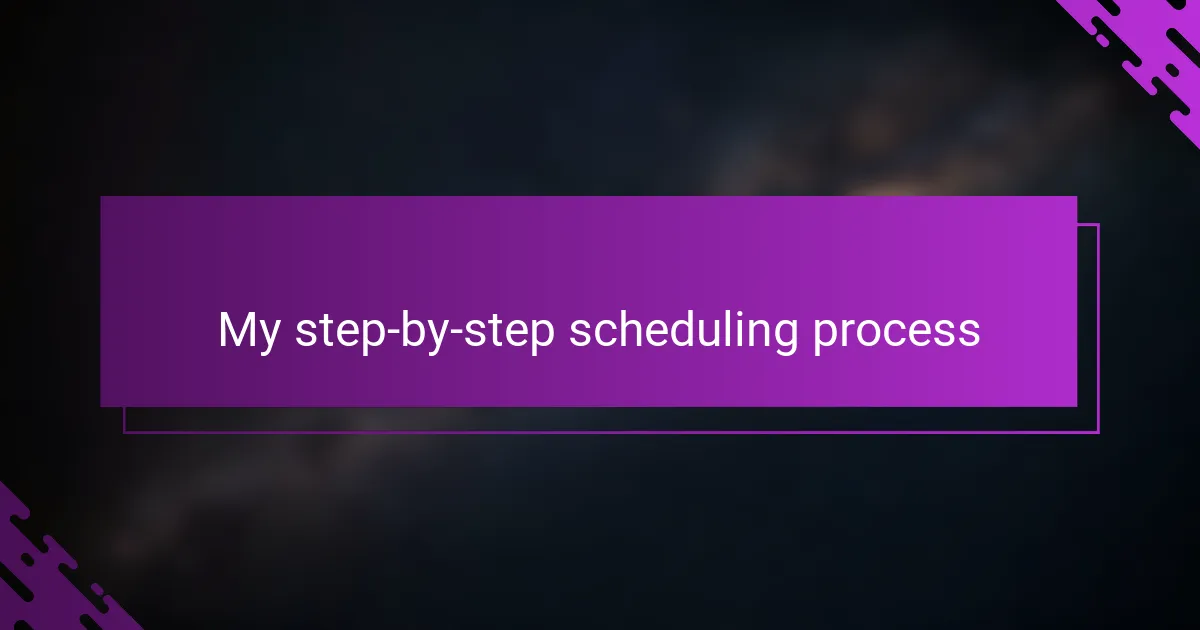
My step-by-step scheduling process
The first step in my scheduling process is gathering all my blog ideas and drafting them in Buffer’s composer. I remember feeling a bit overwhelmed at first, but breaking it down into bite-sized posts helped me take control. Have you ever stared at a blank screen wishing you had a clear plan? Buffer’s draft feature made that all vanish for me.
Next, I slot each post into my custom posting schedule, which I tweak based on when my readers engage most. It’s like setting appointments with my audience, and honestly, seeing those time blocks on the calendar gives me a comforting sense of order. I found myself excited to check in and know my posts would go live exactly when they should.
Finally, I review the queue regularly to shuffle things around or add fresh content if inspiration strikes. There’s something satisfying about watching my blog’s rhythm take shape over weeks ahead. Does knowing your blog is active even when you’re offline make you feel more confident? For me, it’s been a game-changer in turning blogging from stress into a steady creative flow.
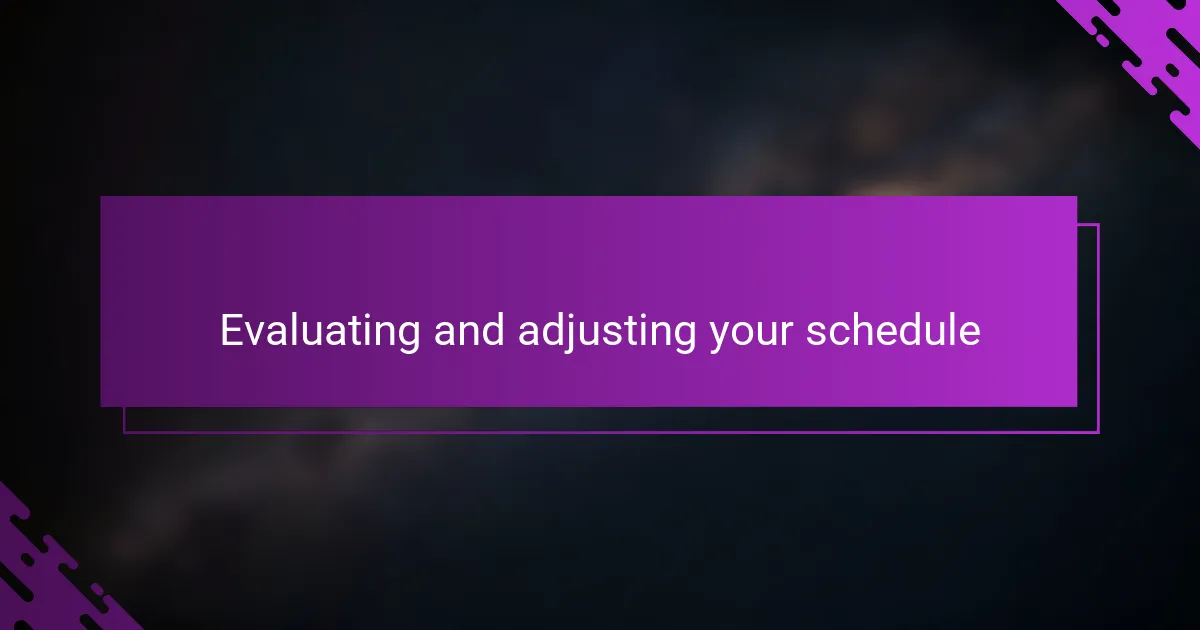
Evaluating and adjusting your schedule
Evaluating how your schedule performs is where the real magic happens. I learned this the hard way when my carefully planned posts didn’t get the engagement I expected. Have you ever wondered if your timing was off, or if your content just wasn’t connecting? Checking Buffer’s analytics helped me spot those gaps and fine-tune everything.
Adjusting my schedule wasn’t just about shifting times—it became a way to listen to my audience’s habits. Sometimes I’d move a post an hour earlier or delay it a day, and surprisingly, those small changes made a big difference. I started to think of my schedule like a living document, not something set in stone.
One insight I can share is how regular evaluation keeps me motivated. When I see certain posts gaining traction, I feel energized to create more in that style or topic. It turned scheduling from a repetitive task into an ongoing conversation with my readers, and that change made all the difference in sustaining my blog over time.
